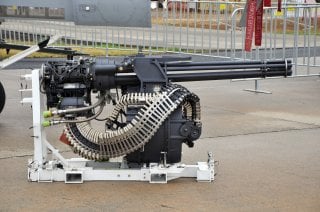General Dynamics M61A2 20mm Gun Was Based on a Civil War Era Design
The General Dynamics M61A2 has one of the fastest cyclic rates of any firearm, yet it is based on a principal that is more than 150 years old.
It isn't possible with the human eye to see a bullet as it leaves the muzzle of a gun, but in the case of the General Dynamics M61A2 20mm rotary cannon, it isn't just a single bullet that can't be seen but literally hundreds each second! With a rate of fire that exceeds 6,600 rounds per minute that is more than 100 rounds leaving the barrels each and every second.
The key to this is the barrels – six of them – which are electrically driven, allowing for both the lightning-fast cyclic rate and in helping keep the barrels from overheating. This also increases multi-hit probabilities when compared to a single barrel.
While this might seem like cutting edge 21st-century technology, the original M61 was developed after World War II by General Electric and first introduced in 1956, but the concept to utilize multiple barrels dates back a century earlier.
It is based on the Gatling principle, which permits a high rate of fire while also reducing heat and barrel erosion. The M61A2 20mm is just the latest generation of the Civil War-era "Gatling Gun," developed by inventor John Gatling, who wasn't looking for a more effective killing machine. Rather he developed his rapid-fire gun as a response to the carnage he witnessed during the American Civil War. Gatling saw how more soldiers died of disease than from gunshots and sought to develop a weapon that could supersede the need for large armies and believed that deaths from the disease would be diminished.
Technically the Gatling Gun wasn't a "machine gun" in the modern sense, as it was hand-cranked – with each crank essentially firing a round and chambering the next one. In this way, it was more of a semi-automatic weapon, but one that had a very quick rate of fire, especially when compared to the muzzleloading rifles of the year. The Gatling Gun actually only saw limited use in the Civil War and wasn't officially used by the U.S. government until 1866, when it was used by the U.S. Cavalry on the frontier until it was declared obsolete in 1911.
One interesting side point is that during his time as president of the Gatling Gun Company, Richard Gatling developed a prototype with an electric motor that allowed his design to reach a rate of fire of nearly 3,000 rounds per minute. By comparison, the various Maxim gun designs that were used during the First World War, including the British Vickers and German MG08, had a rate of fire of just 550-600 rounds per minute.
It took until 1946 for General Electric to be awarded the contract for "Project Vulcan," which led to the development of the M61 20mm Vulcan. Since its introduction, this system has been used on a variety of fixed-wing aircraft including beginning with the F-105D Thunderchief, while the latest M61A2 – which is 20% lighter than the M61A1 version, remains in use on such aircraft as the F-22 and F/A-18.
Peter Suciu is a Michigan-based writer who has contributed to more than four dozen magazines, newspapers and websites. He is the author of several books on military headgear including A Gallery of Military Headdress, which is available on Amazon.com.

